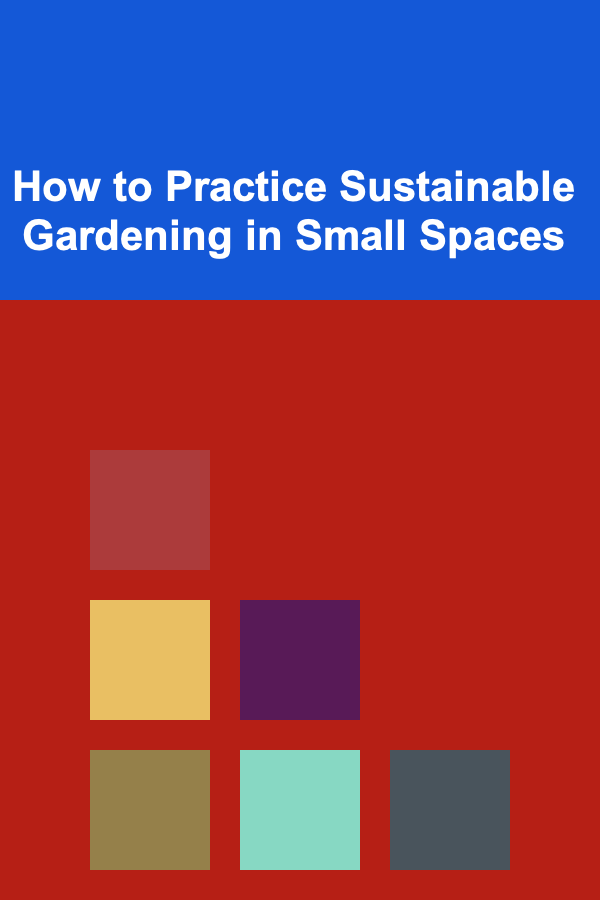
How to Practice Sustainable Gardening in Small Spaces
ebook include PDF & Audio bundle (Micro Guide)
$12.99$8.99
Limited Time Offer! Order within the next:

Gardening is a rewarding and fulfilling activity that connects people to nature, provides fresh food, and enhances mental well-being. However, in today's urbanized world, where space is limited, many people face challenges when trying to grow plants in small spaces. Sustainable gardening is an approach that minimizes environmental impact while promoting biodiversity, reducing waste, and enhancing the quality of life. It is an essential practice for anyone with limited space who wants to cultivate a garden that is both eco-friendly and productive.
In this article, we will explore how to practice sustainable gardening in small spaces, covering topics like efficient space utilization, soil health, water conservation, plant selection, and eco-friendly gardening practices. Through a series of practical tips and techniques, this guide will help you build a garden that thrives in even the smallest of spaces, while contributing positively to the environment.
Understanding Sustainable Gardening
Sustainable gardening refers to practices that minimize the negative impact on the environment while enhancing the natural ecosystem. It involves methods that conserve resources, reduce waste, and protect the health of the soil, air, and water. The goal is to create a balanced and resilient garden that works with nature rather than against it.
Some core principles of sustainable gardening include:
- Conserving water by using efficient irrigation techniques and selecting drought-tolerant plants.
- Soil health is maintained through organic methods like composting and crop rotation.
- Biodiversity is encouraged by planting a variety of species that support beneficial insects and wildlife.
- Waste reduction by reusing materials, composting garden waste, and minimizing the use of harmful chemicals.
By following these principles, you can cultivate a garden that contributes to a healthier environment while also reaping the personal rewards of growing your own food and nurturing plant life.
Maximizing Space in Small Gardens
In small spaces, every inch of garden area counts. Whether you are gardening on a balcony, patio, rooftop, or small backyard, maximizing your space is essential for a productive and sustainable garden. Here are some strategies for making the most of your limited space:
Vertical Gardening
Vertical gardening is an excellent technique for small spaces. By utilizing vertical surfaces, you can grow a variety of plants without taking up precious floor space. Vertical gardening involves growing plants upwards instead of outwards, using structures like trellises, arbors, and fences. This method works particularly well for climbing plants such as peas, beans, tomatoes, and cucumbers. Additionally, hanging baskets or wall-mounted planters can be used for flowers, herbs, and small vegetables.
- Trellises: A simple trellis can be mounted against a wall or fence, allowing plants like tomatoes, peas, and beans to grow vertically.
- Hanging Baskets: Ideal for small spaces like balconies, hanging baskets can hold flowering plants, herbs, or strawberries.
- Living Walls: Living walls or green walls are an increasingly popular option in urban environments. These structures can house a variety of plants, from herbs to ornamental flowers, and are great for maximizing space in city gardens.
Container Gardening
Container gardening is another excellent method for small-space gardening. Using containers like pots, barrels, or even repurposed items (e.g., old buckets, crates, or tires) allows you to grow plants on patios, balconies, or window sills. Containers are versatile, allowing you to move plants around to optimize light conditions or to protect them from extreme weather. You can grow almost anything in containers, from vegetables and herbs to flowers and small fruit trees.
- Grow Bags: These are fabric pots that offer excellent drainage and are ideal for growing vegetables like tomatoes, peppers, and root crops like carrots and potatoes.
- Window Boxes: If you're limited to a small balcony or windowsill, window boxes are a great way to grow herbs, flowers, or even small vegetables like lettuce or radishes.
- Stackable Planters: Stackable planters allow you to grow multiple layers of plants in a small footprint. These are especially effective for herbs or flowers.
Raised Beds
For small urban gardens, raised beds can be a game-changer. Raised garden beds provide several benefits, including better drainage, improved soil structure, and easier access to plants. They also reduce the risk of soil compaction, a common problem in small or heavily trafficked garden spaces. Raised beds can be made from a variety of materials, including wood, stone, or recycled materials like bricks or pallets.
- Modular Raised Beds: These beds come in easy-to-assemble kits and can be arranged to fit the shape of your available space.
- Self-Watering Raised Beds: These are designed with built-in irrigation systems to reduce the need for frequent watering, making them highly water-efficient.
Companion Planting
Companion planting is the practice of growing plants that support each other's growth, whether by attracting beneficial insects, improving soil health, or providing mutual shade or protection. By selecting compatible plants, you can maximize your garden's productivity and health, making it a more sustainable ecosystem. For example, planting basil alongside tomatoes can help repel pests, and growing marigolds with beans can attract pollinators.
Companion planting works particularly well in small gardens because it allows you to grow a variety of plants in close proximity, maximizing the use of available space.
Choosing the Right Plants for Small Spaces
When gardening in small spaces, choosing the right plants is critical for ensuring that your garden is both sustainable and productive. Some plants require more space, while others are compact and well-suited for container gardening or vertical systems. Here are some tips for selecting the right plants for small-space sustainable gardening:
Drought-Tolerant Plants
Drought-tolerant plants are an excellent choice for small-space gardens because they require less water, making them ideal for regions with limited rainfall or water resources. These plants are adapted to survive in dry conditions and are often low-maintenance. Some popular drought-tolerant plants include:
- Succulents: These plants store water in their leaves and thrive in dry conditions.
- Lavender: A hardy herb that requires minimal water and attracts pollinators.
- Cacti: Perfect for sunny, dry spots, cacti come in various sizes and shapes, making them ideal for small gardens.
Edible Plants
Growing your own food is one of the main reasons to practice sustainable gardening. Many edible plants are well-suited for small spaces, and you don't need a large garden to grow a productive food source. Consider planting:
- Herbs: Basil, thyme, oregano, and rosemary are great for container gardening and can be grown on windowsills, balconies, or patios.
- Leafy Greens: Lettuce, spinach, kale, and arugula can be grown in containers or raised beds and harvested frequently.
- Compact Vegetables: Some vegetables, like dwarf varieties of tomatoes, peppers, and zucchini, are bred specifically for small spaces and container gardening.
Native Plants
Native plants are species that naturally occur in your region and are adapted to local growing conditions. They require less water, fertilizer, and maintenance than non-native plants. By choosing native plants, you support local wildlife and contribute to biodiversity. Some examples of native plants for small spaces include:
- Echinacea: Also known as coneflower, this plant attracts pollinators and is well-suited for small gardens.
- Black-eyed Susan: A drought-tolerant plant that produces beautiful yellow flowers and attracts bees.
- Bee Balm: A fragrant herb that attracts bees and butterflies and thrives in a variety of conditions.
Sustainable Gardening Practices
Sustainable gardening is not just about the plants you choose, but also the methods you use to care for your garden. By adopting sustainable practices, you can reduce your environmental footprint while promoting healthier plants. Here are some sustainable gardening practices to incorporate into your small space garden:
Composting
Composting is a sustainable way to recycle organic waste and create nutrient-rich soil for your garden. By composting kitchen scraps, yard waste, and plant material, you can reduce landfill waste and improve soil quality. Composting in small spaces is easy with the right setup:
- Compost Bins: Small compost bins are available for urban gardeners and can be kept on balconies or patios. These bins provide an odor-free, efficient way to compost.
- Vermiculture: Vermiculture, or worm composting, uses worms to break down organic material. Worm bins are small and easy to maintain, making them ideal for small spaces.
Water Conservation
In small spaces, conserving water is essential for sustainability. You can reduce water usage in your garden by adopting practices such as:
- Rainwater Harvesting: Install a rainwater collection system to capture water from your roof, which can be used to irrigate your garden.
- Drip Irrigation: A drip irrigation system delivers water directly to the plant's roots, minimizing waste and ensuring efficient watering.
- Mulching: Use organic mulch like straw, wood chips, or grass clippings to retain moisture in the soil, reduce evaporation, and suppress weeds.
Organic Gardening
Organic gardening avoids the use of synthetic pesticides, herbicides, and fertilizers, which can harm the environment and beneficial insects. Instead, organic gardeners focus on building healthy soil, using natural pest control methods, and fostering biodiversity. Organic practices include:
- Beneficial Insects: Encourage insects like ladybugs, bees, and predatory beetles to control pests.
- Crop Rotation: Rotate plants each season to prevent soil depletion and reduce the risk of pests and diseases.
- Organic Fertilizers: Use compost, manure, or organic fertilizers to enrich the soil without harming the environment.
Reducing Waste
Sustainable gardening also involves reducing waste. You can minimize waste by:
- Recycling containers: Repurpose old containers for plant pots, making your garden more eco-friendly.
- Upcycling: Use discarded items such as pallets, old furniture, and bottles to create planters and garden structures.
- Minimal Packaging: When buying plants or gardening supplies, choose items with minimal or recyclable packaging.
Conclusion
Sustainable gardening in small spaces is not only possible but can also be a rewarding experience. By using vertical gardening techniques, choosing the right plants, and practicing eco-friendly gardening methods, you can create a thriving, low-impact garden that benefits both you and the environment. Whether you are growing food, enhancing your outdoor space, or simply enjoying the process of nurturing plants, small-space gardening offers a unique opportunity to make a positive contribution to the planet while enjoying the many rewards of gardening.
Remember that sustainable gardening is a journey, and every small step you take---whether it's composting, conserving water, or planting native species---adds up over time to make a significant impact. With a little creativity and the right techniques, you can enjoy a beautiful, sustainable garden, no matter how small your space may be.
Reading More From Our Other Websites
- [Home Budget 101] How to Use a Zero-Based Budget for Home Expenses
- [Home Budget Decorating 101] How to Shop for Home Decor at Discount Stores
- [Organization Tip 101] How to Organize Your Luggage by Trip Type
- [Organization Tip 101] How to Batch Similar Tasks for Increased Efficiency
- [Home Rental Property 101] How to Maximize Tax Deductions for Your Rental Property
- [Organization Tip 101] How to Use Trunk Organizers for Better Storage Solutions
- [Organization Tip 101] The Best Energy-Efficient Appliances for Homeowners in 2025
- [Home Maintenance 101] How to Use an Instant Pot for Quick and Easy Meals
- [Home Storage Solution 101] How to Combine Home Storage and Decor for a Stylish Space
- [Personal Financial Planning 101] How to Create a Personal Financial Plan on a Low Income

How to Host a Holiday Party and Decorate Your Home for Guests
Read More
How to Organize Your Bathroom with Space-Saving Storage Ideas
Read More
How to Use Financial Ratios to Assess Your Financial Health
Read More
How to Find Exciting Surf Spots
Read More
How To Find Affordable Accommodation Worldwide
Read More
10 Tips for Staying Productive as a Scientist
Read MoreOther Products

How to Host a Holiday Party and Decorate Your Home for Guests
Read More
How to Organize Your Bathroom with Space-Saving Storage Ideas
Read More
How to Use Financial Ratios to Assess Your Financial Health
Read More
How to Find Exciting Surf Spots
Read More
How To Find Affordable Accommodation Worldwide
Read More